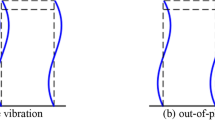Abstract
Designing structures to be the least vulnerable within earthquake-prone areas is a serious challenge for structural engineers. One common and useful tool that structural engineers use to predict the vulnerability of a structure during an earthquake is a fragility curve. However, most structural fragility curves do not take into consideration the contribution of pile foundation systems in the structural vulnerability. Therefore, this study aims to modify existing fragility curves of a six-story fixed-base steel frame hospital building with buckling-restrained braces, to incorporate the effect of helical pile group behavior on the fragility of the structure. To that end, a finite element model of the investigated structure was modified with results from a full-scale shake table test performed on two groups of helical piles embedded in dense sand supporting a superstructure. The primary results show that fixed-base design may not be conservative for all conditions and soil–foundation interaction should be considered when creating fragility curves, especially for a stiff structure on soft soils where a high-intensity earthquake is anticipated.









Similar content being viewed by others
References
Allred SM (2018) Seismic performance of grouped helical piles in fixed and pinned connections. Master of Science, University of Oklahoma
American Society of Civil Engineers. (2017). Minimum design loads and associated criteria for buildings and other structures: ASCE/SEI 7–16
Darendeli MB (2001) Development of a new family of normalized modulus reduction and material damping curves. Doctor of Philosophy, University of Texas at Austin
El-sawy M (2017) Seismic performance of steel helical pile. Master of science, Master of science, The University of Western Ontario
Federal Emergency Management Agency. FEMA 577 (2000) Recommended seismic evaluation and upgrade criteria for existing welded steel moment-frame buildings, Washington, DC
Federal Emergency Management Agency. FEMA P695 (2009) Quantification of building seismic performance factors, Washington, DC
Federal Emergency Management Agency. FEMA P-58-1 (2012) Seismic performance assessment of buildings. Applied Technology Council (ATC)
Hassan EM, Mahmoud H (2017) Modeling resolution effects on the seismic response of a hospital steel building. J Constr Steel Res 139:254–271
Hassan EM, Mahmoud H (2018) A framework for estimating immediate interdependent functionality reduction of a steel hospital following a seismic event. Eng Struct 168:669–683
HAZUS-MH 2.1 (2003) Multi-hazard loss estimation methodology earthquake model. Washington, DC: FEMA-National Institute of Building Sciences
Karapetrou ST, Fotopoulou SD, Pitilakis KD (2015) Seismic vulnerability assessment of high-rise non-ductile RC buildings considering soil–structure interaction effects. Soil Dyn Earthq Eng 73:42–57
Karim KR, Yamazaki F (2001) Effect of earthquake ground motions on fragility curves of highway bridge piers based on numerical simulation . Earthq Eng Struct Dyn 30:1839–1856
Kinali K (2007) Seismic fragility assessment of steel frames in the central and eastern United States. Doctor of Philosophy, Georgia Institute of Technology, Georgia Institute of Technology
Kinali K, Ellingwood BRJE (2007) Seismic fragility assessment of steel frames for consequence-based engineering: a case study for Memphis, TN. Eng Struct 29(6):1115–1127
Mahmoud HN (2011) Seismic behavior of semi-rigid steel frames. Doctor of Philosophy, University of Illinois at Urbana-Champaign
Mahmoud HN, Elnashai AS, Spencer BF Jr, Kwon O-S, Bennier DJ (2013) Hybrid simulation for earthquake response of semirigid partial-strength steel frames. J Struct Eng 139(7):1134–1148
Mekki M, Elachachi SM, Breysse D, Zoutat M (2016) Seismic behavior of R.C. structures including soil-structure interaction and soil variability effects. Eng Struct 126:15–26
Mouroux P, Brun BL (2003) RISK-UE. An advanced approach to earthquake risk scenarios with applications to different European towns
Nakhaei M, Ghannad MA (2008) The effect of soil–structure interaction on damage index of buildings. Eng Struct 30(6):1491–1499
NEHRP Consultants Joint Venture (2013a) Cost analyses and benefit studies for construction in Memphis, Tennessee. Gaithersburg, MD
NEHRP Consultants Joint Venture (2013b) Cost analyses and benefit studies for construction in Memphis, Tennessee (design drawings). Gaithersburg, MD
Nielson BG (2005) Analytical fragility curves for highway bridges in moderate seismic zones. Doctor of Philosophy, Georgia Institute of Technology
Padgett JE (2007) Seismic vulnerability assessment of retrofitted bridges using probabilistic methods. Doctor of Philosophy, Georgia Institute of Technology
Park Y-J (1985) Seismic damage analysis and damage-limiting design for r/c structures (earthquake, building, reliability, design). University of Illinois at Urbana-Champaign
Park Y-J, Ang AH-S, Wen YK (1985) Seismic damage analysis of reinforced concrete buildings. J Struct Eng ASCE 111(4):740–757
Porter K (2016) A beginner’s guide to fragility, vulnerability, and risk. University of Colorado Boulder
Rajeev P, Tesfamariam S (2012) Seismic fragilities of non-ductile reinforced concrete frames with consideration of soil structure interaction. Soil Dyn Earthq Eng 40:78–86
Shahbazi M, Cerato AB, Allred S, El Naggar MH, Elgamal AW (2020) Damping characteristics of full-scale grouped helical piles in dense sands subject to small and large shaking events. Can Geotech J. https://doi.org/10.1139/cgj-2018-0769
Shahbazi M, Cerato AB, El Naggar H, Elgamal A (2020) Evaluation of seismic soil-structure interaction of full-scale grouped helical piles in dense sand. Int J Geomech. https://doi.org/10.1061/(ASCE)GM.1943-5622.0001876
Shinozuka M, Feng MQ, Lee J, Naganuma T (2000) Statistical analysis of fragility curves. J Eng Mech ASCE 126(12):1224–1231
Shome N, Cornell CA, Bazzurro P, Carballo JE (1998) Earthquakes, records, and nonlinear responses. Earthq Spectra 14(3):469–500
Tang Y, Zhang J (2011) Probabilistic seismic demand analysis of a slender RC shear wall considering soil–structure interaction effects. Eng Struct 33(1):218–229
Tehrani MH, Harvey PS (2019) Generation of synthetic accelerograms for telecommunications equipment: fragility assessment of a rolling isolation system. Bull Earthq Eng 17(3):1715–1737
Uang C-M, Maarouf A (1994) Deflection amplification factor for seismic design provisions. J Struct Eng 120(8):2423–2436
Vamvatsikos D, Cornell CAJEE, Dynamics S (2002) Incremental dynamic analysis. Earthq Eng Struct Dyn 31(3):491–514
Author information
Authors and Affiliations
Corresponding author
Additional information
Publisher's Note
Springer Nature remains neutral with regard to jurisdictional claims in published maps and institutional affiliations.
Rights and permissions
About this article
Cite this article
Shahbazi, M., Cerato, A.B., Hassan, E.M. et al. Seismic risk assessment of a steel building supported on helical pile groups. Acta Geotech. 17, 289–301 (2022). https://doi.org/10.1007/s11440-021-01207-8
Received:
Accepted:
Published:
Issue Date:
DOI: https://doi.org/10.1007/s11440-021-01207-8




